Torrey Canyon: How marine life is returning to the Cornish coast 50 years after one of world’s worst oil spills
Exactly 50 years ago today, the SS Torrey Canyon crashed into rocks off the Cornish coast, spilling more than 100,000 tonnes of crude oil into the English Channel. David Barnett looks back at the first major oil spill in British and European waters – and what we’ve learned since
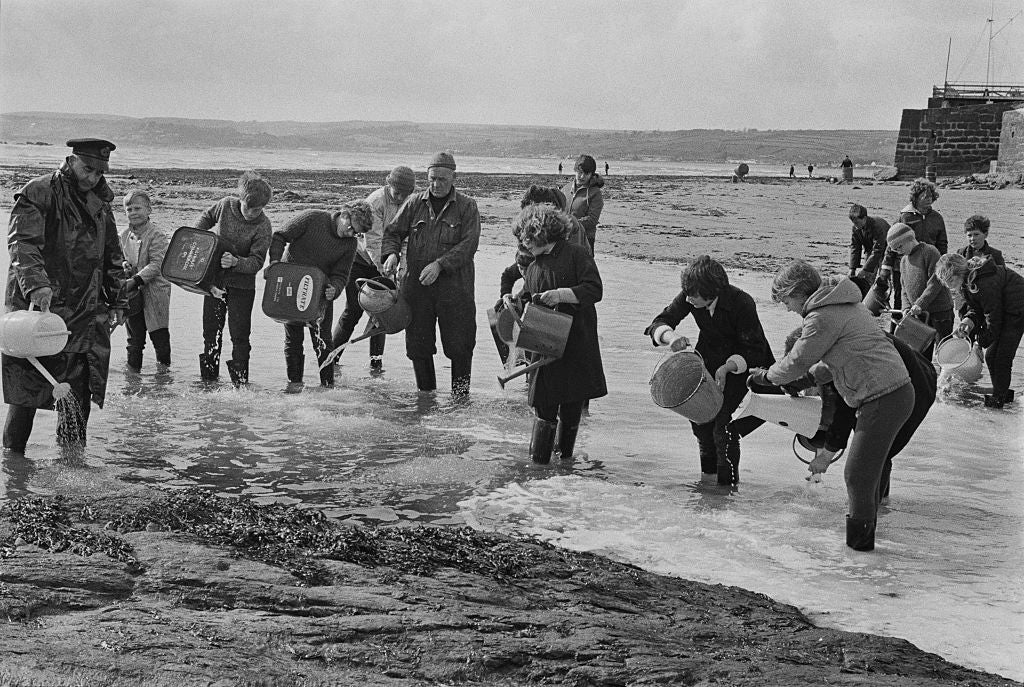
Every summer, Richard Pearce returns to the Cornish beaches, as he has done for the past 50 years. Perhaps nothing too remarkable in that, but it’s not just the beauty of the rugged coastline that draws him, year after year, though Richard is in the process of selling up in London and settling in Cornwall permanently.
No mere holidaymaker, Richard – or rather, Dr Pearce – visits the coast each summer to carry out his own scientific survey of the marine flora and fauna which he’s watched gradually return after the first and so far worst marine environmental disaster in the UK, and one of the most significant in the entire world.
Exactly 50 years ago today the SS Torrey Canyon, a Liberia-registered tanker chartered to British Petroleum, was wrecked on rocks off the Cornish coast. The ship, built in the USA in 1959, had the capacity to carry 120,000 tons of crude oil, and with a full cargo was on her way from a refinery in Kuwait to Milford Haven in Wales when disaster struck.
What followed were dramatic scenes as the authorities first bombed the stricken ship, then employed napalm in a bid to burn off the oil, and finally resorted to an untested and quickly-developed detergent to try to mitigate the effects of the worst oil spill in British history.
The week after the Barracuda Tanker Corporation ship hit Pollard’s Rock on Seven Stones Reef, 15 miles west of Land’s End, Dr Pearce married his wife, Jo, and they honeymooned on the Isles of Scilly. He remembers, “We flew by helicopter right over the wreck. It was a very dramatic sight. We could see this long pennant of oil spreading out from the Torrey Canyon.”
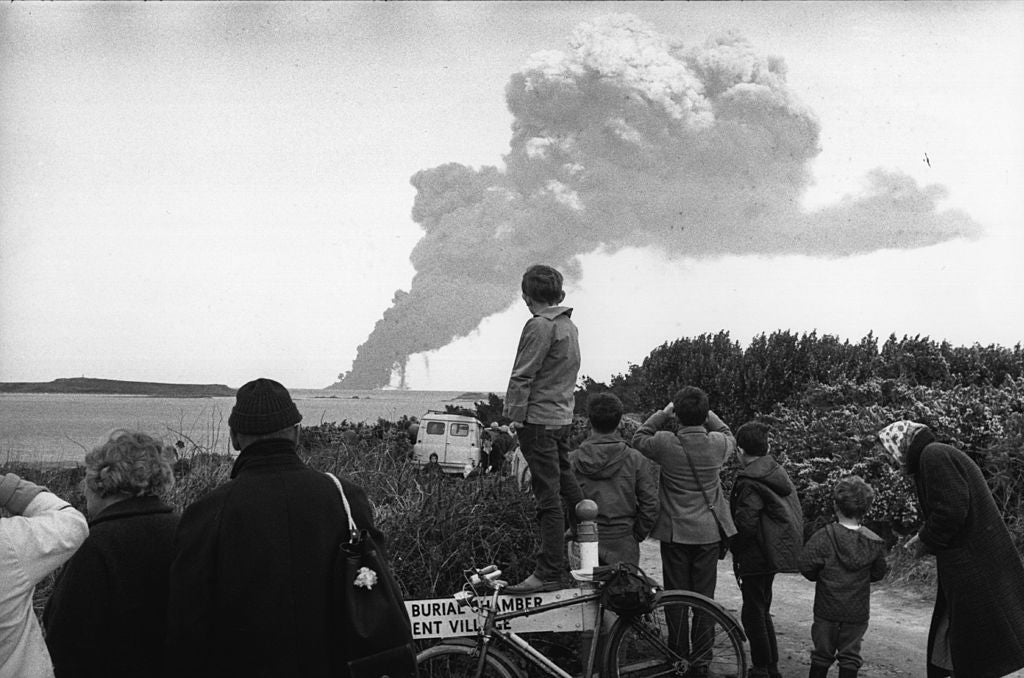
While they were honeymooning, the newlyweds were treated to another dramatic performance: the bombing of the tanker. To sink the ship, the government sent in the Fleet Air Arm and the Royal Air Force; the first with Buccaneers which dropped 1,000lb bombs to break up the wreckage, the second with Hawker Hunters to fuel the blaze and hasten the demise of the Torrey Canyon by dropping cans of kerosene jet fuel. “From the beach on Scilly we could see the black cloud rising up. It was 1967 and of course we hadn’t been at war for many, many years, so it was a thing to behold, seeing all these warplanes and bombers flying overhead.”
A biologist, Dr Pearce was a biology teacher at the time of the wrecking of the Torrey Canyon. When they returned back to Cornwall the oil that the air strikes had failed to burn off was in the process of making landfall on the county’s beaches and rocky coast.
But what caused the wreck in the first place? An inquiry in Liberia, held there because that’s where the ship was registered, found that the Torrey Canyon ran aground on the rocks because of human error driven by economic pressures. The ship was headed for the deep-water terminal in Wales, and the captain had been informed from Milford Haven that low tide was nigh there. The crew knew that if they missed the high tide they might have to wait up to five days before the water was deep enough for the 297m ship to enter the dock.
To save time, the captain ordered the ship should go between Cornwall and the Isles of Scilly, rather than around the Scillies as originally planned, despite being unfamiliar with the area and of the existence of the Seven Stones Reef, which had claimed as many as 200 ships since the first recorded incident in 1656, when the 22-gun man o’ war The Primrose sank while in pursuit of a Spanish frigate.
Wrecked, its crew rescued, and bombed into pieces, the Torrey Canyon sank and lies 100ft down. But the real damage was just beginning, as Dr Pearce found on his return from honeymoon and the deadly cargo of crude oil began to pollute the Cornish coast.
As well as the authorities acting to at first contain the spill and then clean up in the aftermath, there was a swift community response. Local people tried to clear up the huge slicks that beached, especially on the Cornish coast, and attempted to load up fishing boats with the oil and dump it out to sea.
And Dr Pearce returned to find that his father-in-law was at the centre of the local response. TO Darke, known to all as Bob, was Jo’s father and a farmer at Treburrick on the north Cornwall coast. He was married to the actress Betty Cowan, and a renowned ornithologist and naturalist. The locals turned to him for help and advice and to co-ordinate the clean-up.
“He was just desperate about the damage being caused,” says Dr Pearce. “He could stand on his farm, on the cliffs above the coast, and see the oil washing up.”
It wasn’t just the mess, of course. It was the effect on wildlife. Dr Pearce recalls, “We had something like 20-30,000 seabirds affected, and that’s just an estimate of those who came ashore. We don’t know how many died at sea. Some of them could be cleaned up. Others…” Dr Pearce pauses, remembering being down on those beaches with his father-in-law, faced with hundreds of oiled birds. “Some had to be put out of their misery. Bob was a farmer, he knew what to do, and together we had to do it. It was unpleasant but necessary.
“There was a huge amount of damage to the beaches. Some places were just smothered with oil, and it was pretty pernicious stuff. And it smelled terrible.”
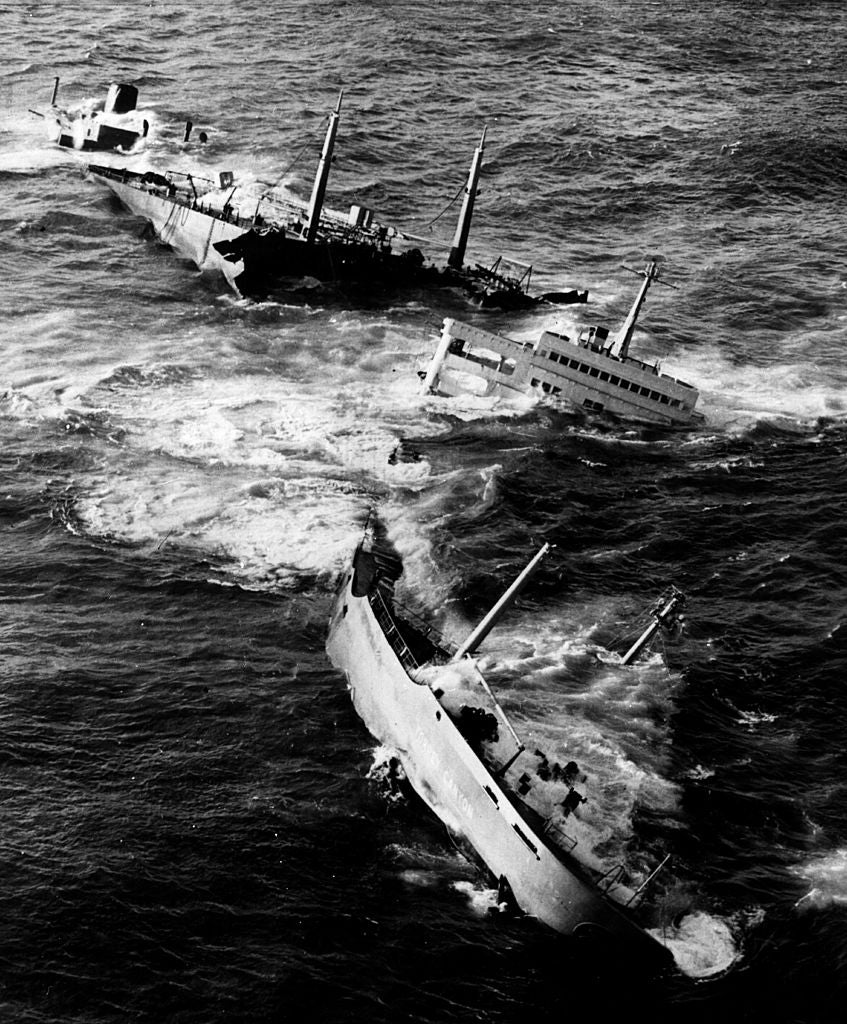
While the community was engaging in the tough task of dealing with the fall-out of the spillage, the government was hard at work on a more widespread solution. This was, as Dr Pearce says, in the days of Labour Prime Minister Harold Wilson’s famous “white heat of technology” drive to boost Britain’s scientific and technical industries. The boffins got to work immediately on a solution to the Cornish contamination.
“Harold Wilson had a home on the Isles of Scilly and he ordered the scientists to create something that would do the job quickly. They came up with BP 1002. It was supposed to be a magic bullet that would disperse the oil and get rid of it.”
The Army was brought in to distribute the new formula, pouring barrels of it over the oil on the beaches, spraying it on the sea-bound slicks. It did the job it was meant to, which was a relief to many.
It was Easter by the time BP 1002 was deployed. Tourist destinations such as Newquay had already written off the season and were desperate that the oil would be gone in time for the Summer exodus to Cornwall.
However, the government response to the Torrey Canyon incident was by this time under close scrutiny by the media. The mood was turning against the way it had been dealt with, doubtlessly driven in no small part by an incident Dr Pearce recalls when the national press were invited to a junket where Cornwall was going to be proclaimed to be open for business. Some local government mandarin with an eye on keeping costs down decided the planned drinks and sandwiches in a Truro hotel was unnecessary lavish, and relocated the event to a council chamber – with no refreshments. “The press of course ripped into them,” says Dr Pearce. “It was a complete disaster.”
Among the awkward questions the press started to ask were why the bombing of the wreck had been such a failure. A quarter of the bombs dropped by the FAA and the RAF completely missed what was effectively a sitting duck. The high seas kept putting out the fire, meaning the military resorted to carpet-bombing it with napalm. Inflatable booms set up to contain the slicks proved next to useless. And then the Harold Wilson’s rapidly-developed detergent was found to be doing just as much harm as good.
Dr Pearce says, “Most of the oil was eventually cleared and the detergent probably hastened that. But it killed almost everything in the sea and on the coast.”
Dr Pearce knew the TV botanist David Bellamy (who has in recent years fallen out of favour with broadcasters due to his views on climate change) and had gone on an expedition with him to Spain. He brought Bellamy in to Cornwall to assess the damage of the slick and the detergent. “I asked him how long he thought it might take for things to get back to normal. He said he had absolutely no idea. Nothing like the oil slick had ever happened before, and nothing as powerful as BP 1002 had ever been used.”
So it was then that Dr Pearce, whose wife sadly died in 2010, began what would be an annual survey of the limpets, mussels, crabs, seaweeds, any and every form of marine life that was common to the Cornish coasts, on the beach below his father-in-law’s farm.
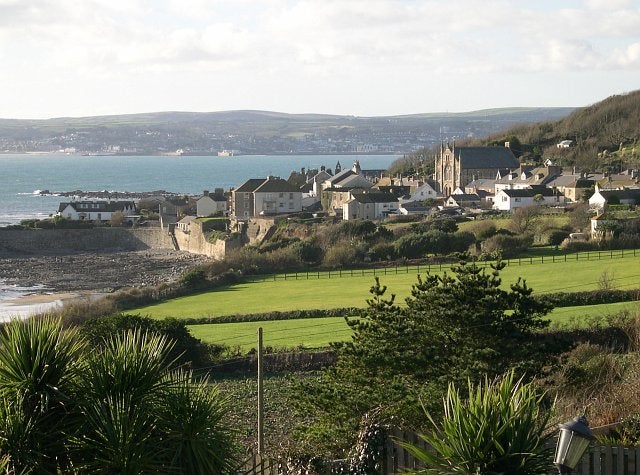
His latest survey from last year – he is preparing for this year’s – found in his control area that there were 600 limpets on the rocks. This has been a fairly steady number in the last few years. In the first year, about four weeks after the detergent had been used, he found just five.
Dr Pearce estimates that it took around five years for the marine life to recover from the slick and the detergent. As he didn’t do the surveys before the spill he can’t, as a scientist, say that today’s results mean the wildlife is back to its pre-slick levels, but he does know that the numbers he’s seen over the past few years have remained constant.
It was the view of Dr Pearce and many local people that the detergent was unnecessary. They thought that nature would heal itself, that it would find a way to naturally cleanse the beaches and ecological infrastructure of the crude oil from the Torrey Canyon, over time.
“The detergent was definitely a mistake,” he says. “There had been no tests on the toxicity of it, it was designed to do one job – clear the oil – and the environmental implications of its use just weren’t considered.”
Would the coast have recovered without it? It’s difficult to say there hadn’t been a spill the size of Torrey Canyon before, and there hasn’t been one since. Tougher regulations on oil transportation since 1967 mean that there might never again be a disaster on the scale of the Torrey Canyon.
Although Dr Pearce feels that the ecology stabilised within perhaps four or five years, the true scale of the effect on the environment of the oil and the detergent has never been fully known. But a rather happy postscript to this story does suggest that Dr Pearce might be right when he says nature can find a way to bounce back from even the worst excesses of humanity.
Matt Slater, the Marine Awareness Officer at the Cornwall Wildlife Trust, tells me that last year volunteers from the trust discovered a tiny hermit crab on the beaches called Clibanarius eryhtropus.
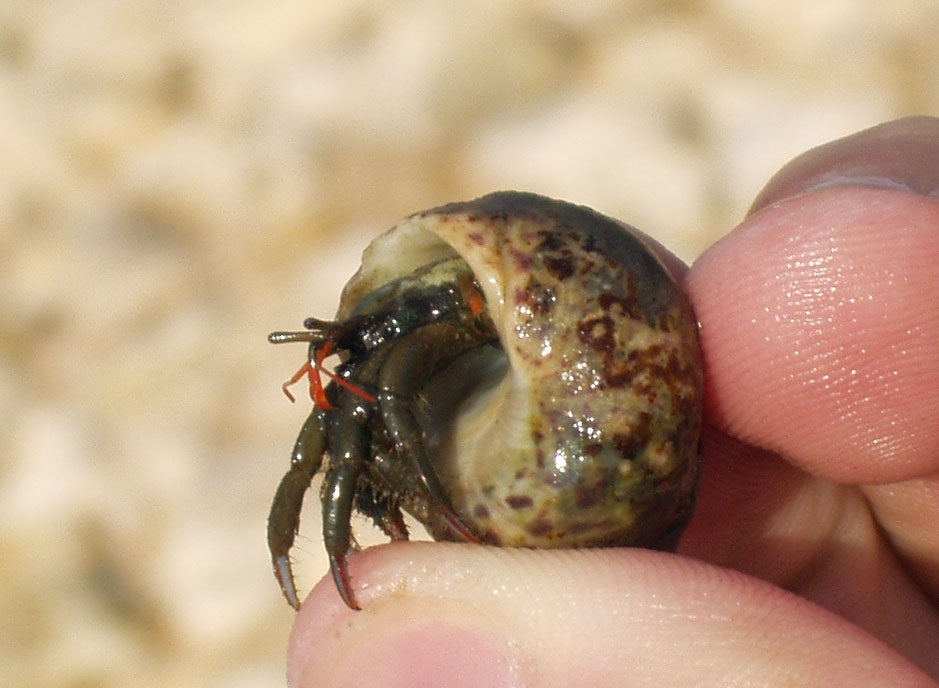
It’s more commonly known now – thanks to viewers of BBC’s Springwatch programme, who voted to give it a name – as St Piran’s crab. Its discovery in Cornwall was significant because it hadn’t been seen in large numbers since just before the Torrey Canyon spill.
It’s named for the patron saint of Cornwall, and legend tells that St Piran was tied to a millstone by heathens and rolled off a cliff to certain death in the waters below. But the stormy sea calmed and St Piran floated to the safety of the shore.
It’s a fitting name for the little crab who, against the odds, has returned to the Cornish coast half a century after one of the worst oil spills in history. As Dr Pearce and many in Cornwall believe, no matter how badly we humans treat it, nature and the sea delivers… eventually.
Join our commenting forum
Join thought-provoking conversations, follow other Independent readers and see their replies
Comments
Bookmark popover
Removed from bookmarks